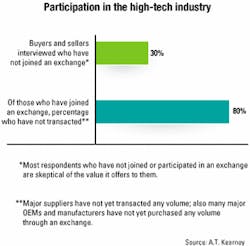Taste of success keeps distributors online
The best sales strategies acknowledge that e-commerce has as many definitions as Baskin-Robbins has varieties of ice cream.
BY WINN HARDIN
Investors, IT managers, and newly appointed Internet sales managers have all struggled with the claims of e-commerce software companies and service providers. In the past five years, executives invested millions in supply-chain enablement software, private and public exchanges, collaborative tools, and online catalog services.
Despite these efforts, a share of the purported trillion-dollar online business-to-business market is still proving elusive for many. Several optoelectronic component distributors and equipment vendors have managed to stay ahead of the e-commerce curve, however. Here's what's working and why.
Arrow Electronics Inc. (Melville, NY), a global distributor of electronic and optoelectronic components with sales of $13 billion last year, adopted electronic data interchange (EDI) early on and had reserved a domain name on the Internet (arrow.com) by 1991. Today, 20% of Arrow's volume is ordered through electronic means. The electronics industry was an early participant in ANSI's EDI and is leading the way to a similar group of standards for Internet e-commerce through the Rosettanet organization (www.rosettanet.org).
Despite this acceptance of electronic procurement, Tom Hallam, president of Arrow's Internet Business Group, is quick to dispel the idea that electronic sales exclude the human touch. "Salespeople maintain the personal relationships that keep Arrow's customers happy," he asserts.
Typically, Arrow receives orders from customers for components 26 weeks out from the delivery date. The order is often revised based on changes in demand, inventory, and the market. On top of the constant revisions, Hallam points out that the market itself has changed considerably. Twenty years ago when he started his career, distributors carried tens of thousands of parts, most of which were commodities and in stock at multiple vendors. Today, the number of components in a distributor's catalog has grown to several million, many of which are customized, made to order, and not in stock anywhere other than a distributor's warehouse. As a result, the need to communicate with all parts of the supply chain and quickly react to changing conditions in a complex market is pushing Arrow onto the Internet.Using one tool in Arrow's arsenal, Arrow customers can track or change component orders from any browser on any PC in real time. "The Web tools have the same point of interface to the Arrow host system as the sales team does on their desktop," explains Hallam. "If someone wakes up in a cold sweat and can't remember if they ordered a part or needs to check on tomorrow morning's delivery, they can do it through our Web tools."
Arrow's competitor, Phoenix-based Avnet Inc., uses the Internet to tie together component information across the dozens of individual Avnet companies that represent some $12.3 billion in annual revenue in 63 countries. Representing clients with product lines as diverse as Agilent, Tyco, Mindspeed, and Conexant, Avnet's vice president of marketing, Carl Cohen, says his company's parametric-part search engine, Part-
Builder, has already reduced sales overhead by reducing the need for data books and shipping.
PartBuilder allows engineers to drill down to a selection of compatible parts based on operational parameters. Like other tools of its type, PartBuilder is tied in to Avnet's inventory database to give engineers immediate pricing and availability. PartBuilder's success with the engineers in the field has strengthened the information ties between distributor and manufacturer.
"Initially, the burden is on us to get the [part information] from the manufacturer. It's a proof-of-concept thing," explains Cohen. But as the suppliers' sales force starts to use the tool, and they notice that their product information is not up to date, they champion PartBuilder internally and force fresh information from their company to Avnet. More information translates to more sales opportunities, re-gardless of whether the transaction takes place online or offline.
The bad news, according to Arrow's Hallam, is that developing a parametric search engine is not always cheap. The good news is that it's cheap to operate.
"Engineers realize that they get credible information and it's better than searching multiple Websites for the same information. It's one of the most actively used features of the Website," says Cohen. Avnet also takes advantage of collaborative tools developed by their partner companies by organizing the site into industry- or application-specific portals and linking to manufacturer-owned design tools such as Agilent's AppCAD.
Collaborative tools represent one way a high-tech company can boost sales using the Internet. Mir Aamir, a management consultant at A.T. Kearney (Chicago), tells of his work to help NEC develop a soon-to-be-released collaborative ASIC design tool. The concept was to make a tool that allows small OEM customers-design engineers-to come online and look at all the permutations of the NEC product portfolio. "An engineer can start to design an ASIC or other component without the need to bother NEC engineers," Aamir explains. That frees up staff engineers for more lucrative projects.
More than just creating an online habit among engineers, Aamir maintains that the right set of Internet tools can help balance the incentive game companies play with their distributors. Under the old rules, distributor salespeople have financial incentives to push one company over another, typically in the absence of deep design knowledge. Online tools help companies that might be getting the short end of the stick from their distributors, because the tool can deliver the design knowledge that a distributor's salesperson cannot. And of course, once engineers come to the site and use the tool, they will be more likely to buy from NEC. At least that is the theory.
Nevertheless, Internet sales still represent a fraction of each company's revenue. For Arrow's Hallam, Internet sales are "insignificant" compared to EDI and human sales but show growth commensurate with the growth of online banking and trading-around 1-2% per year. That growth has accelerated recently as the economic downturn forces fewer to do more in less time.
Avnet's Cohen echoes Hallam's optimistic pragmatism, adding that objective metrics on site usage tied to the bottom line are hard to get. A six-month old survey shows that while 70% of high-tech companies have opted to join some Internet exchange as a way to share the costs of e-commerce development, only 20% of those have actually transacted business online, according to A.T. Kearney's Aamir.
These sobering numbers play into the worst fears of the post dot-com crash. But for some market leaders, the question isn't about taking a credit-card number or about Internet billing systems, it's improving the entire customer experience.
Cisco Systems (San Jose, CA), provider of Internet networking equipment and optical communications infrastructure for companies worldwide, knows where its bread is buttered and acts accordingly. "Everything you do here at Cisco, you do online," explains John DiLullo, director of e-sales for global operations at Cisco.
A lion's share of Cisco's success depends on a global partner network in an industry where equipment changes constantly and solutions are complex. Education is the key, DiLullo says, not just for internal sales but for partners as well. "We use the Internet not just to give customers information, but to keep our sales force up to speed on what's happening with our customers and products."
Through real-time delivery of news clips or equipment failure notifications at key accounts, connecting requisition networks from large accounts across the Internet into Cisco's own purchasing network, or customer-based Internet portals to ease purchase decisions, Cisco illustrates a multifaceted Internet sales strategy that seems to work.
While the Internet figures heavily into Cisco's success, online-only vendors have taken Internet-based sales a step further. Unfortunately, many of these vendors have gone under. Others, like TestMart.com (San Bruno, CA), continue to evolve. TestMart smartly focused its public exchange on an underserved market with broad applicability to many industries. The distributor stayed ahead of the dot-com crash by remaining private, focusing on the end result, shifting strategy, and partnering with a brick-and-mortar institution: the U.S. Navy.
According to TestMart CEO Peter Ostrow, used equipment led to a "price-shopper" mentality. "People would look all over the Website and then call us and say, 'I found it for $60 less. Are you going to come down or do I go somewhere else.' That's bad for business," observes Ostrow.
Price-shoppers will enjoy TestMart's new initiative for companies with access to the General Purpose Electronic Test Equipment (GPETE) division at the Department of Defense Naval Inventory and Control Point (NAVICP). "Anybody who knows will go there for the price," notes Ostrow. While the site will not offer every test equipment manufacturer's entire catalog, the equipment in the department's $15-billion inventory is priced far below commercial rates.
All of these companies use the Internet to enhance their sales strategies with varying degrees of success. The three most important questions a company should ask when creating an Internet sales strategy, according to A.T. Kearney's Aamir:
- What and how diverse is the customer base?
- How complex is the purchasing procedure?
- What is the product mix?
Diverse customer bases may require multiple efforts such as specific portals for key customers and collaborative tools for smaller customers that free human overhead for larger projects. The Internet can be used to simplify parts of the purchasing procedure; however, Aamir cautions that intelligent bill-of-material software that aids in design choices may be a year or so away. Custom products may require online design tools to improve sales, while commodity sales may only require a system for updating and searching data books tied into the backend of the company's inventory system.
Winn Hardin is a technology writer based in Neptune, FL. He can be reached at [email protected].
Lightwave is interested in reader feedback. Why not drop us a line at [email protected]?


